STM32F4: Generating parallel signals with the FSMC
STM32F4: Generating parallel signals with the FSMC
The goal: The memory controller can be used to generate a "generic" 16-bit parallel data stream with clock. Address generation will be disregarded, as well as other control signals dedicated to memory chips.
It must be noted that the STM32F40x and STM32F41x have the FSMC (static memories), while theSTM32F42x and STM32F43x have the FMC (static and dynamic memories). The differences between the two concern the support of SDRAM (dynamic RAM), address and data write FIFOs (both data and address, instead of data only for FSMC, and 16-word long instead of 2-word long only for FSMC), and the 32-bit wide data bus for FMC (See [1]).
Set pins (1st attempt)
Only data bus FSMC_D[15:0] and clock FSMC_CLK will be used (set as alternate function). The other pins are set as standard GPIOs (general purpose output).
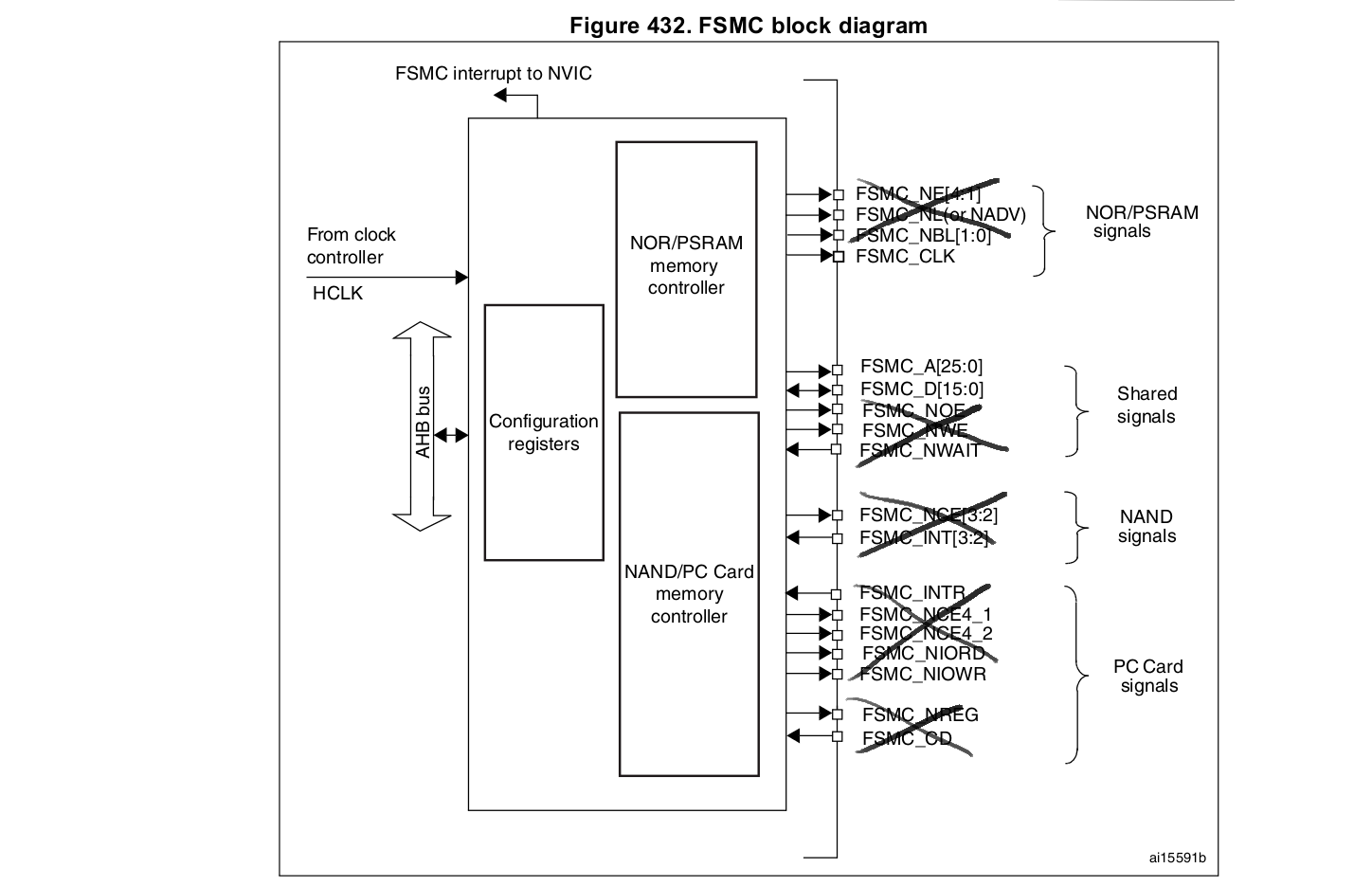
FSMC is alternate function 12 according to the datasheet (See "Table 9. Alternate function mapping" in [2]).
/* PD: 0, 1, 3, 8, 9, 10, 14, 15 -> alternate function (0b10) */
GPIOD->MODER = 0xA56A559A;
GPIOD->AFR[] = 0xCCCCCCCC; /* FSMC = AF12 (0xC) */
GPIOD->AFR[] = 0xCCCCCCCC;
/* PE: 7, 8, 9, 10, 11, 12, 13, 14, 15 -> alternate function (0b10) */
GPIOE->MODER = 0xAAAA9555;
GPIOE->AFR[] = 0xCCCCCCCC;
GPIOE->AFR[] = 0xCCCCCCCC;
FSMC setup/init (1st attempt)
Be careful of the the wicked register map documentation of the FSMC block:
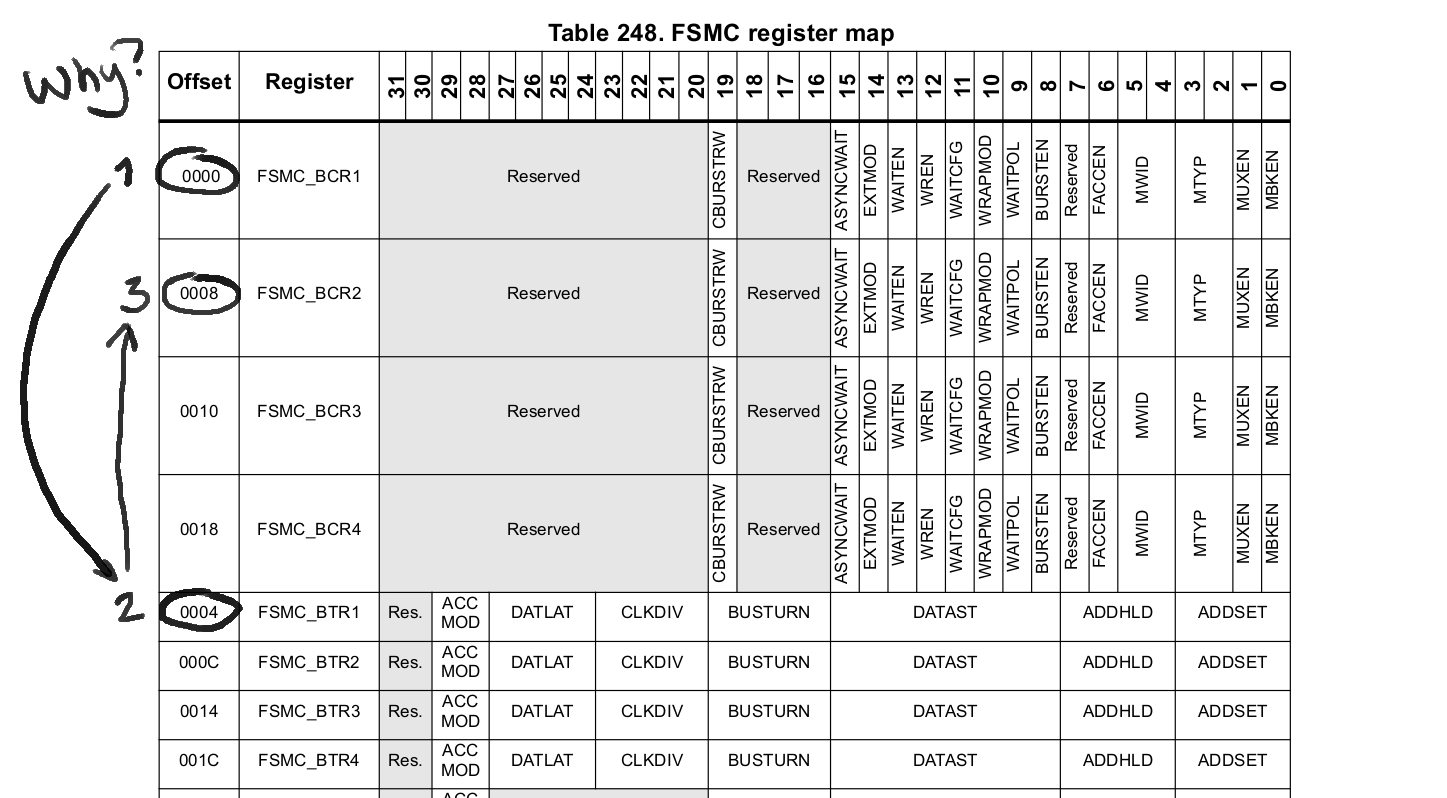
This is very misleading, since all other table are ordered as found in memory, but not here.
/* PSRAM, synchronous (burst), non-multiplexed */
/* control register */
FSMC_Bank1->BTCR[] = FSMC_BCR1_CBURSTRW | FSMC_BCR1_WAITPOL | FSMC_BCR1_BURSTEN | FSMC_BCR1_MWID_0 | FSMC_BCR1_WREN | FSMC_BCR1_MTYP_0 /* PSRAM */ | FSMC_BCR1_MBKEN;
/* timing register */
FSMC_Bank1->BTCR[] = FSMC_BTR1_CLKDIV_1 /* div 3 */ ;
It is noticable that the timing are all set to 0, except the clock.
Result (1st attempt)
The code writing to the FSMC is using an array and simulate a sequencial memory request, in order to take advantage of the burst mode.
volatile uint16_t* fsmc = (uint16_t*)0x60000000;
for(uint32_t i=; i<(sizeof(bitstream_bin)/); i++) {
uint16_t w = ((uint16_t*)bitstream_bin)[i];
fsmc[i] = w;
}
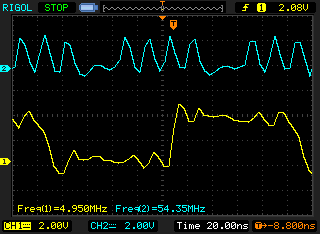
The clock is ~54MHz, but the maximum clock is HCLK/2 = 168/2=84MHz. Unfortunately, my oscilloscope is too slow for this.
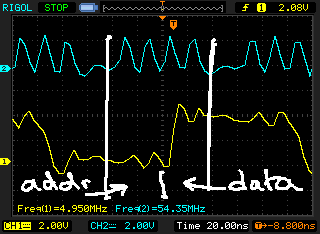
At least, 4 clock cycles are required to write one data. Data latency (DATLAT lowest value is 2). There is one cyle to give the address, two cyle of latency, one cyle for give the data.
At max FSMC speed (~84MHz), after dividing the clock by 4, the 16-bit parallel transmission would only be ~20MHz.

Bursts are possible up to 32 bits (two 16-bit data words). When using this feature, two data words are send for each address, hence more data is sent, but the clock is hard to use: 3 ticks for the (empty) address, 1 tick for the first data, 1 tick for the second data (5 cycles for 2 data, ~30MHz max).
Set pins (2nd attempt)
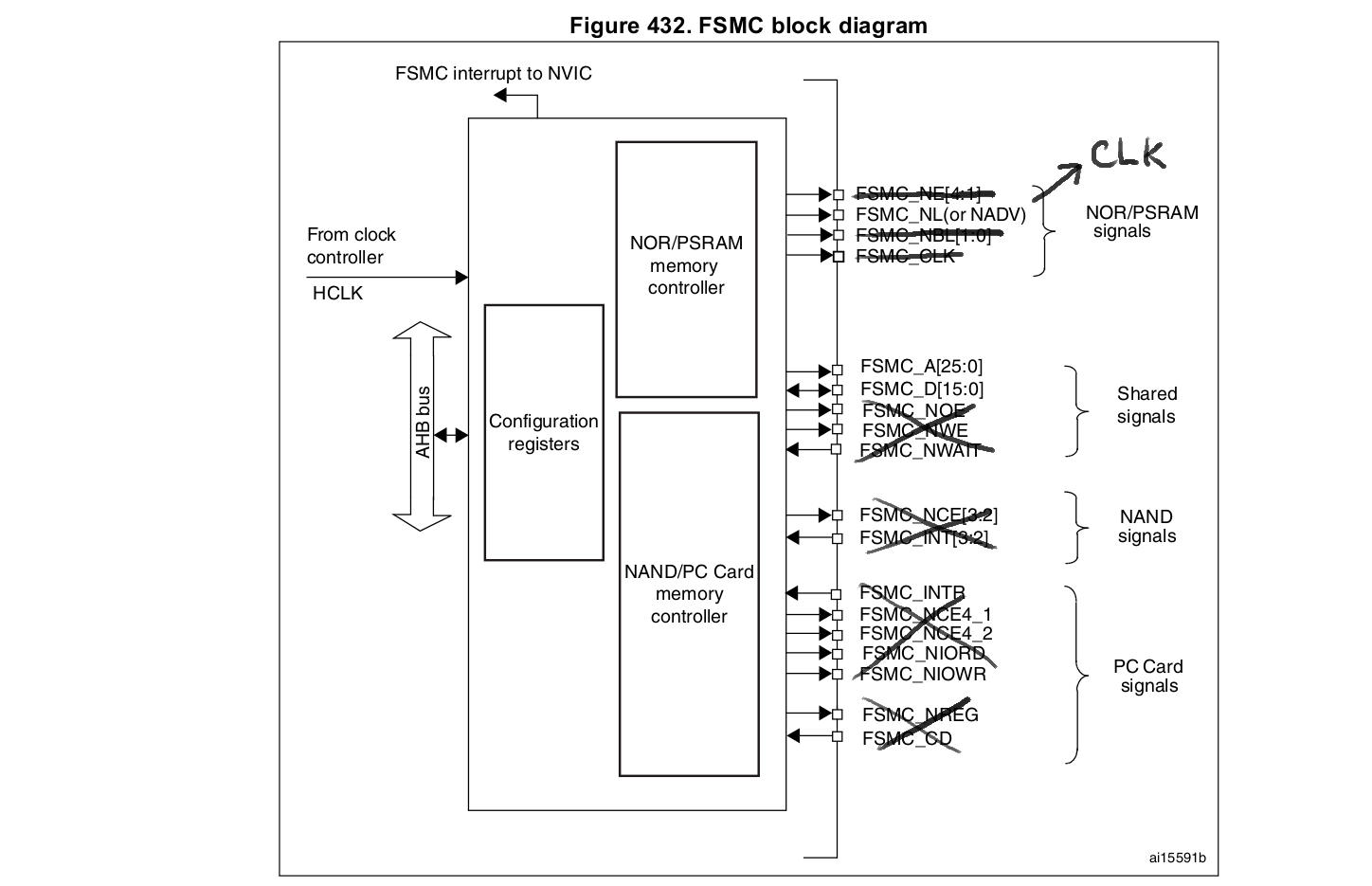
/* PD: 0, 1, 8, 9, 10, 14, 15 -> alternate function (0b10) */
GPIOD->MODER = 0xA56A555A;
GPIOD->AFR[] = 0xCCCCCCCC; /* FSMC = AF12 (0xC) */
GPIOD->AFR[] = 0xCCCCCCCC;
/* PE: 7, 8, 9, 10, 11, 12, 13, 14, 15 -> alternate function (0b10) */
GPIOE->MODER = 0xAAAA9555;
GPIOE->AFR[] = 0xCCCCCCCC;
GPIOE->AFR[] = 0xCCCCCCCC;
/* PB: 7 -> AF */
GPIOB->MODER = 0x55551555;
GPIOB->AFR[] = 0xCCCCCCCC;
GPIOB->AFR[] = 0xCCCCCCCC;
FSMC setup/init (2nd attempt)
/* NOR flash, asynchronous, multiplexed */
/* control register */
FSMC_Bank1->BTCR[] = FSMC_BCR1_WREN | FSMC_BCR1_FACCEN | FSMC_BCR1_MWID_0 /* 16-bit */ | FSMC_BCR1_MTYP_1 /* NOR flash */ | FSMC_BCR1_MUXEN | FSMC_BCR1_MBKEN;
/* timing register */
FSMC_Bank1->BTCR[] = FSMC_BTR1_CLKDIV_0 | FSMC_BTR1_DATAST_0 | FSMC_BTR1_ADDHLD_0 | FSMC_BTR1_ADDSET_1;
Result (2nd attempt)
We want to use the NADV signal as a new clock CLK.
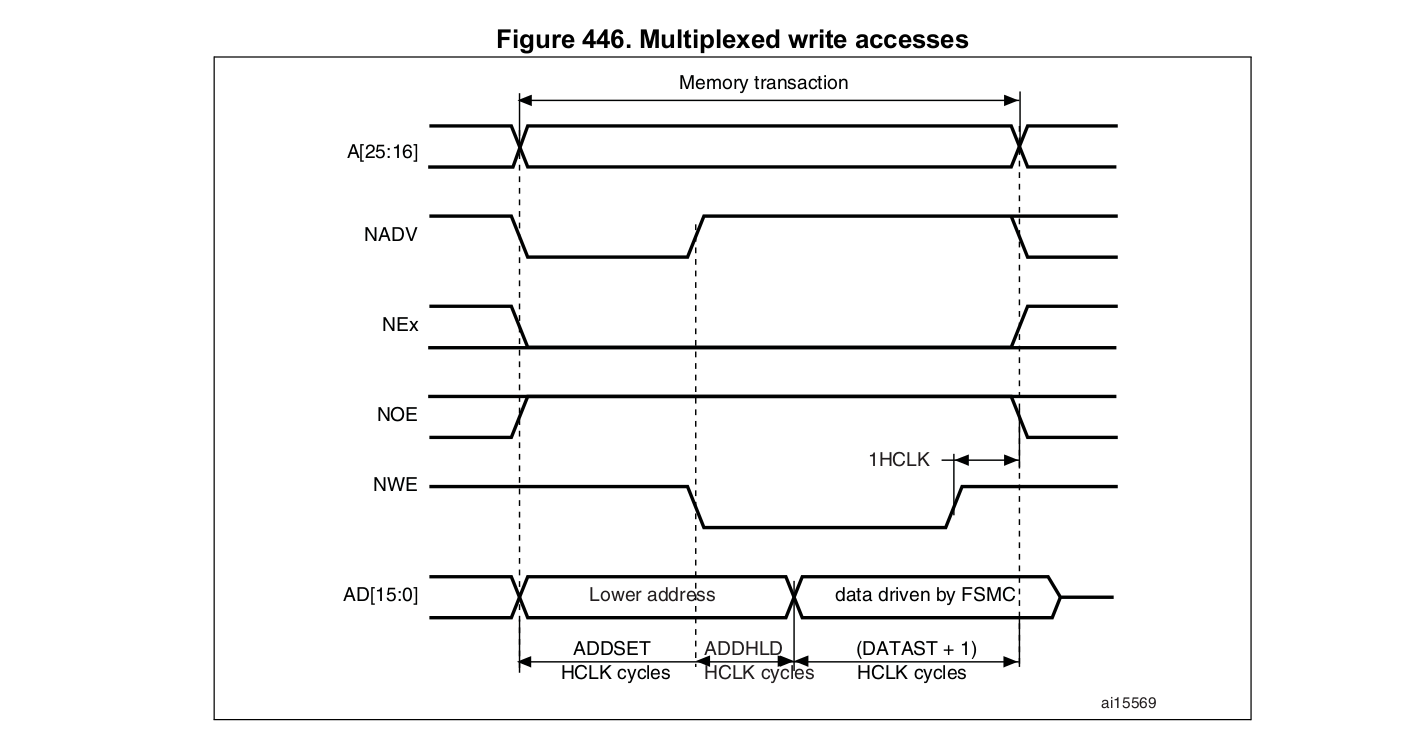
volatile uint16_t* fsmc = (uint16_t*)0x60000000;
uint16_t w[] = {
0xFFFF, 0x0000, 0xFFFF, 0x0000,
0xFFFF, 0x0000, 0xFFFF, 0x0000}; for(uint32_t i=;i<;i++) {
fsmc[] = w[i];
}
We write to the same address in order to force a new memory transaction and cycle NADV.
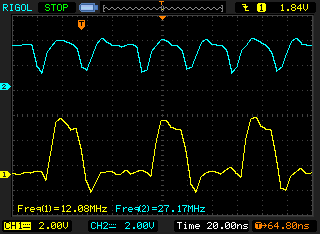
The problem is that the data bus is updated after the positive edge of the NADV "clock". This issue can be overcome by multiplexing the address and data bus and put the data value as address. The ADDSET value is also increased in order to have a more balanced clock (ADDSET=3).
for(uint32_t i=;i<;i++) {
uint16_t v = w[i];
fsmc[v] = v;
}
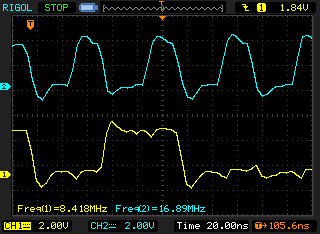
Unfortately, the overall clock speed decreased because the address "trick".
Conclusion
A "nice looking" 16-bit parallel signal with clock can be generated at approx. 16MHz using the memory controller (FSMC) in asynchronous NOR Flash mode. 20MHz can be achieved with an external clock divider (div 4) in synchronous PSRAM mode. If the clock edge can be aligned with the data edge, 27MHz is possible from SRAM.
Note: the FMC (Flexible Memory Controller, also supporting SDRAM) in SDRAM mode can generate a synchronous burst of one data per clock. In this case, 84MHz is possible in theory. I haven't the hardware to test it.
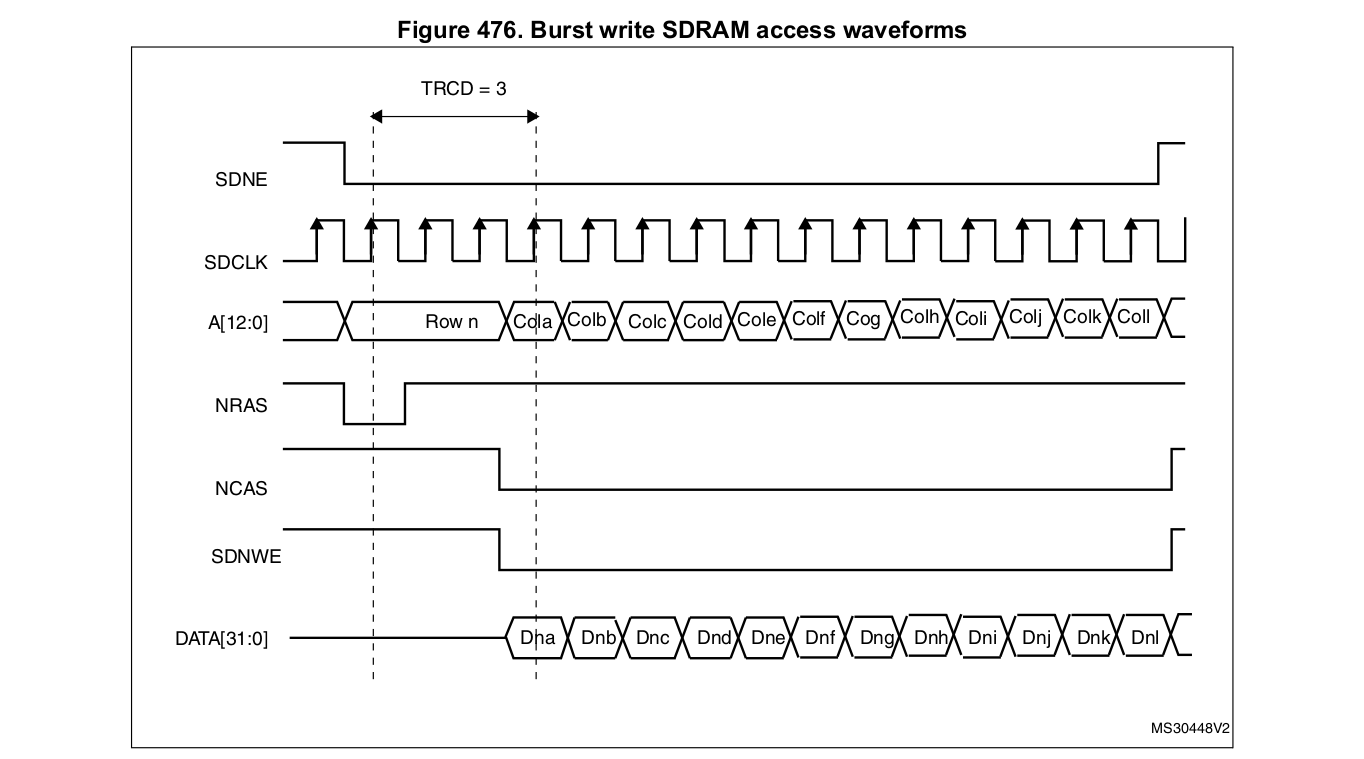
STM32F4: Generating parallel signals with the FSMC的更多相关文章
- STM32F4: GENERATING A SINE WAVE
http://amarkham.com/?p=49
- Flexible implementation of a system management mode (SMM) in a processor
A system management mode (SMM) of operating a processor includes only a basic set of hardwired hooks ...
- PMP用语集
AC actual cost 实际成本 ACWP actual cost of work performed 已完工作实际成本 BAC budget at completion 完工预算 BCWP b ...
- 论文翻译:2021_DeepFilterNet: A Low Complexity Speech Enhancement Framework for Full-Band Audio based on Deep Filtering
论文地址:DeepFilterNet:基于深度滤波的全频带音频低复杂度语音增强框架 论文代码:https://github.com/ Rikorose/DeepFilterNet 引用:Schröte ...
- STM32F4—fsmc的配置步骤
0:开启GPIO时钟和FSMC时钟 1:配置GPIO 2:配置片选控制寄存器 3:配置片选时序寄存器 4:配置写入时序寄存器 GPIO_InitTypeDef GPIO_InitStructure;/ ...
- STM32F4 SPI with DMA
STM32F4 SPI with DMA A few people have requested code, so I thought I’d post the code showing how I’ ...
- Generating Complex Procedural Terrains Using GPU
前言:感慨于居然不用tesselation也可以产生这么复杂的地形,当然致命的那个关于不能有洞的缺陷还是没有办法,但是这个赶脚生成的已经足够好了,再加上其它模型估 计效果还是比较震撼的.总之好文共分享 ...
- GNU Parallel Tutorial
GNU Parallel Tutorial Prerequisites Input sources A single input source Multiple input sources Linki ...
- Massively parallel supercomputer
A novel massively parallel supercomputer of hundreds of teraOPS-scale includes node architectures ba ...
随机推荐
- Shell命令行中特殊字符与其转义详解(去除特殊含义)
特殊符号及其转义 大家都知道在一个shell命令是由命令名和它的参数组成的, 比如 cat testfile, 其中cat是命令名, testfile是参数. shell将参数testfile传递给c ...
- 第一篇:初始Golang
Golang简介 编程语言已经非常多,偏性能敏感的编译型语言有 C.C++.Java.C#.Delphi和Objective-C 等,偏快速业务开发的动态解析型语言有PHP.Python.Perl.R ...
- 【PE结构】恶意代码数字签名验证
说明 恶意代码数字签名验证功能,WinverityTrust.CryptQueryObject 代码实现 WinVerifyTrust //------------------------------ ...
- pip2和pip3冲突问题解决方法
python使用pip安装模块时报错:unable to create process using ' '的解决方法: 参考:http://qoogle.cn/?id=39 1.删除C:\Python ...
- linux网络编程--Circular Buffer(Ring Buffer) 环形缓冲区的设计与实现【转】
转自:https://blog.csdn.net/yusiguyuan/article/details/18368095 1. 应用场景 网络编程中有这样一种场景:需要应用程序代码一边从TCP/IP协 ...
- 大数据系列之并行计算引擎Spark部署及应用
相关博文: 大数据系列之并行计算引擎Spark介绍 之前介绍过关于Spark的程序运行模式有三种: 1.Local模式: 2.standalone(独立模式) 3.Yarn/mesos模式 本文将介绍 ...
- 【题解】BZOJ 1901: Zju2112 Dynamic Rankings
题目传送门(权限题) 一道类似的非权限题 题意 N个数的序列,每次修改一个数或者询问区间里的第K小.可以离线. 简要做法 假如要求在线,可以树状数组套个线段树~ 但是这题是可以离线的,就可以乱搞整体二 ...
- zabbix报警Too many processes on zabbix server
zabbix大量报警,运行进程过多,但实际有部分机器可以忽略,需要关闭相关的报警 Configuration-->Templates找到Template_Linux点该行的 Triggers选择 ...
- python文件操作及格式化输出
1 文件与IO 1.1读写文本数据 读写各种不同的文本数据,如ASCII,UTF-8,UTF-9编码等. 使用带有rt模式的open()函数读取文本文件. 例如: with open('db', 'r ...
- Redis Scan命令
原地址:https://www.cnblogs.com/tekkaman/p/4887293.html [Redis Scan命令] SCAN cursor [MATCH pattern] [COUN ...
